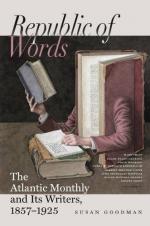Seven Little People and their Friends. New York: A.F. Randolph.
This is a charming book for the holidays. Not that it requires such a temporary occasion to give it interest, elevated as it is by its inherent excellence above that class of books which may be said almost entirely to depend upon such factitious accidents for whatever of success they may reasonably hope to obtain. It is, irrespective of time or occasion, a genuine story-book, adapted particularly to children between the ages of six and sixteen years, yet not, as is usually the case in books for children, confined to these narrow limits in either direction; since there is somewhat for any child that can be supposed to have an interest in narrative, and a great deal for every man who has genius, according to Coleridge’s well-known definition of genius,—namely, that it is the power of childhood carried forward into the developments of manhood. This is saying, indeed, quite as much as could be said for the general features of the book, and more than could be said for any other child’s book, excepting alone Hans Andersen’s inimitable stories.
Speaking of the book as compared with the works of Hans Andersen, it is more consciously a work of art, in an intellectual sense; it is more complicated in incident, or rather, we should say, in the working-up of the incident, whether that be an advantage for it or not. In almost every instance, Hans Andersen’s stories could be told apart from the book,—indeed, it is true that many of them were thus told to children, whom the Danish storyteller casually met, before they were committed to writing; and they were written, we imagine, very much as they were told. The seven stories of which this book is made up, on the other hand, could none of them be told naturally, and yet preserve every artistic feature which belongs to them, as they are written. As there is more of intellectual consciousness in their development, giving them more finish and greater multiformity as products of art, so also there is more depth of idea in their design. The writer is evidently not satisfied with simple narrative; the movement of his stories is more important in his eye than incident, and to the former there must have been considerable sacrifice of the latter,—that is, much of the incident which might have been given in a simple narrative has been left out, because it would mar the formal design.
From what has been said it will be evident that the book is not one of those designed to affect the reader mainly through a scrupulous conscience, or indeed distinctively through conscience at all. It appeals to the imagination preeminently, and through that to the will. It is the greatest merit of the book, that it is designed for the culture and development of the imagination in children,—a faculty almost entirely neglected, or, what is worse, oftentimes despotically crushed and thwarted in children.




